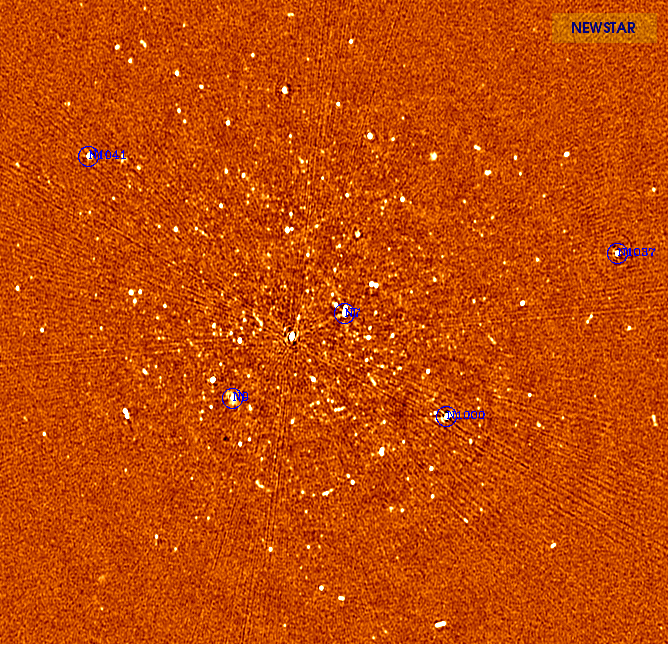Daily Image
15-02-2010"Luxury" Problems of High Dynamic-Range Imaging
| Submitter: | Oleg Smirnov |
| Description: | For the last few decades or so, radio astronomical images with the highest dynamic range have been made by Ger de Bruyn, using the WSRT and the NEWSTAR data reduction package. Naturally, this became the target to beat for aspiring designers of new data reduction software. The pictures above demonstrate that this lofty goal has been achieved for the field around the bright source 3C147 (22 Jy at 21cm), at a dynamic range approaching 2 million. The most prominent remaining artifacts in the NEWSTAR map shown here are residual patterns around a few of the "second echelon" (~tens of mJy) off-axis sources, and very faint radial spokes centered on 3C147 itself. The residual patterns are caused by subtle direction-dependent effects (DDEs) such as pointing errors, non-identical beams, and tropospheric refraction, which normal selfcal does not deal with (beyond absorbing their time- and antenna-independent parts into the source flux solutions.) With MeqTrees, we have removed these effects by adding solvable source- and antenna-dependent differential gain terms to the Measurement Equation. The differential gain solutions make for a fascinating story in themselves (watch this space.) Dealing with DDE's is called "3rd Generation Calibration" (3GC), and will be essential for the next generation of giant radio telescopes. It will also help to improve the results of existing telescopes, some of which have been upgraded recently. In this context, the demonstration that rather faint off-axis sources can be used to measure and remove DDE's is very encouraging. Dealing with DDE's is very much easier with MeqTrees, which has been especially designed for 3GC. MeqTrees is based on an explicit, but arbitrary, Measurement Equation, with 2x2 Jones matrices for all instrumental effects (which is essential to get the polarization right!), and in principle allows for arbitrary parameterization of the DDE's. As for the radial spokes, they seem to be present in other WSRT datasets as well, but only show up at the million+ dynamic range (a luxury problem indeed!) They are still not adequately understood. In this particular dataset, we have shown that the spokes are somehow linked to antenna RTC, and can be moderated by aggressive flagging on baselines to RTC ("MeqTrees 1" image), or removed entirely by excluding RTC ("MeqTrees 2" image), at a small cost in sensitivity and uv-coverage. And while this latter operation can be performed with any reduction package, it is the pervasive visualization capabilities of MeqTrees that helped us narrow the spokes down to antenna RTC. NB: This AJDI, and its follow-up AJDI next week, will be discussed in a presentation at the astronomer's lunch at ASTRON, next wednesday (17 feb). |
| Copyright: | MeqTrees Foundation |
| Tweet |  |
